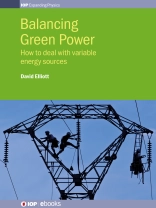Renewable energy sources are large but some are variable and intermittent. The widescale use of renewable energy sources for energy supply will require the adoption of ways to compensate for their variability. This book reviews the technical options looking at their pros and cons and how they might work together to support a reliable and sustainable energy system. This is a rapidly advancing area of research and practice, and Balancing Green Power offers an ideal introduction to the field.
表中的内容
1. Introduction: balancing variations Renewable energy sources are large but some are variable and intermittent. The use of variable sources for energy supply will require some way of compensating for this variability. Power grids already balance variations in conventional energy supply and variations in energy demand and the approaches used for this can be expanded to deal with renewables up to quite high levels of renewable penetration. The main current option is to use fossil plants to back up renewables. However at higher levels of renewable penetration, other, additional, balancing mechanisms may also be needed, including energy storage, smart grid demand response and supergrid imports and exports. This introductory chapter outlines the options, which are then explored in more detail in the rest of the book. 2. The story so far: balancing with fossil plants Fossil fuel-fired power plants are used to balance variations in grid energy supply and variations in demand, by ramping output up and down. Some types of modern gas fired plants can do this rapidly and with relatively low efficiency losses. With renewables on the grid, they would have to do this more often, imposing a small extra cost and leading to a small reduction in the carbon emissions avoided by using renewables. The latter can be avoided by using green energy sources to fuel the gas plants, but there may be limits to how much green gas will be available. In principle, gas plants can provide balancing for both short-term variations and long-term lulls, using stored fuel. Nuclear plants may not be able balance short-term variations but might play a role in dealing with long lulls. Some types of renewables are less variable and can play a role in short and possibly longer term balancing, but fossil plant backup remains the most popular and cheapest option at present. 3. The next challenge: energy storage Energy can be stored in a variety of ways and at various scales for both the short and long term. Smaller scale short-term options include batteries, longer term bulk storage options include pumped hydro reservoirs. Energy storage is generally expensive, but provides a way to deal with surplus outputs from renewable energy generators, enabling the excess energy to be used later, when there is lull in renewable output and/or a rise in demand. Storing gas and heat is easier than storing electricity, so it may be best in some situations to convert electricity generated from renewable sources into heat, liquid air or synthetic gasses, although there will be conversion loses. Solar or biomass generated heat can be stored directly for subsequent use in meeting heating needs at various scales. Larger systems are usually more cost effective, as is true for most forms of storage, but some domestic-scale options may be viable. 4. Grid links to the future Renewable energy availability varies by time and location, so one way to deal with this is to transmit it from where it is available to where it is needed. That is what is already done with fossil gas, and sometimes also, over shorter distances, with heat. Renewable heat and gas supplies can be treated in the same way. So can renewably generated electricity. Electricity transmission by high voltage AC grid links is widely utilized, but it’s not as efficient over long distances as transmission using high voltage DC. HVDC supergrids can be used to balance local variations in renewable supply and local energy demand across whole regions or continents, making use of geographically-defined weather-related variations in availability. In addition to long distance trading of local surpluses, it is also possible to use smart grid systems, perhaps in conjunction with variable ‘time of use’ pricing arrangements, to manage variable demand and supply, by delaying demand peaks via temporary disconnection of high loads. 5. System integration The various options for grid balancing looked at so far all have pros on cons. No one single option seems viable across the board. Studies have attempted to ascertain what the optimal mix in technical, environmental and economic terms might be in a variety of contexts. This chapter reviews some examples of such studies covering potential interactions, conflicts and trade off amongst candidate options. For example, the availability of supergrids would reduce the need for storage and vice versa. It may also be, as one study asserts, that even taken together, storage, smart grids and supergrids may not be enough to avoid continued use of fossil backup or reliance on nuclear energy. The final likely, or best, mix of balancing options is thus still open to debate and will of course depend on what supply mix emerges. 6. Conclusions: making changes As the use of renewables expands, it has become necessary to provide grid balancing facilities. This final chapter looks at how this type of development has been promoted, focusing on the different market- based approaches being adopted in the UK and Germany. It is far from clear which the best approach is, but it does seem clear that as renewables develop the emphasis will move away from large baseload plants to more flexible energy systems both for supply and demand management. That transition is currently uneven, in that, for example, unlike Germany, the UK for still supporting large centralised nuclear projects. Whether that approach will avoid balancing problems is far from clear. But the flexibility concept would suggest that it will not. More likely a shift to new more decentralised supply technology will become the norm and will require a shift to new balancing technology. In which case we need to decide on the right mix and ensure that it is ready.
关于作者
David Elliott is an Emeritus Professor of Technology Policy at The Open University, UK, where he pioneered courses and research focussing on renewable energy and innovation policy. He has authored numerous books, reports and papers, especially in the area of the development of sustainable and renewable-energy technology systems. Balancing Green Power follows on from his last book, Renewables: A review of sustainable energy supply options, published by IOP ebooks.












